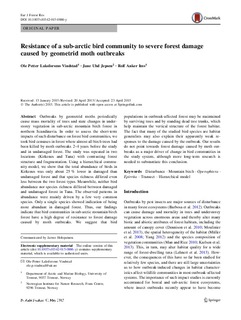| dc.contributor.author | Laksforsmo Vindstad, Ole Petter | |
| dc.contributor.author | Jepsen, Jane Uhd | |
| dc.contributor.author | Ims, Rolf Anker | |
| dc.coverage.spatial | Northern Scandinavia | nb_NO |
| dc.date.accessioned | 2015-05-04T11:51:09Z | |
| dc.date.accessioned | 2016-07-14T12:11:12Z | |
| dc.date.available | 2015-05-04T11:51:09Z | |
| dc.date.available | 2016-07-14T12:11:12Z | |
| dc.date.issued | 2015 | |
| dc.identifier.citation | European Journal of Forest Research 2015 | nb_NO |
| dc.identifier.issn | 1612-4669 | |
| dc.identifier.uri | http://hdl.handle.net/11250/2396538 | |
| dc.description.abstract | Outbreaks by geometrid moths periodically cause mass mortality of trees and state changes in understorey vegetation in sub-arctic mountain birch forest in northern Scandinavia. In order to assess the short-term impacts of such disturbance on forest bird communities, we took bird censuses in forest where almost all birch trees had been killed by moth outbreaks 2–4 years before the study and in undamaged forest. The study was repeated in two locations (Kirkenes and Tana) with contrasting forest structure and fragmentation. Using a hierarchical community model, we show that the total abundance of birds in Kirkenes was only about 25 % lower in damaged than undamaged forest and that species richness differed even less between the two forest types. Meanwhile, neither bird abundance nor species richness differed between damaged and undamaged forest in Tana. The observed patterns in abundance were mainly driven by a few very common species. Only a single species showed indication of being more abundant in damaged forest. Thus, our findings indicate that bird communities in sub-arctic mountain birch forest have a high degree of resistance to forest damage caused by moth outbreaks. We suggest that bird populations in outbreak-affected forest may be maintained by surviving trees and by standing dead tree trunks, which help maintain the vertical structure of the forest habitat. The fact that many of the studied bird species are habitat generalists may also explain their apparently weak responses to the damage caused by the outbreak. Our results do not point towards forest damage caused by moth outbreaks as a major driver of change in bird communities in the study system, although more long-term research is needed to substantiate this conclusion. | nb_NO |
| dc.language.iso | eng | nb_NO |
| dc.rights | Navngivelse-Ikkekommersiell-DelPåSammeVilkår 3.0 Norge | * |
| dc.rights.uri | http://creativecommons.org/licenses/by-nc-sa/3.0/no/ | * |
| dc.subject | Disturbance | nb_NO |
| dc.subject | Mountain birch | nb_NO |
| dc.subject | Operophtera | nb_NO |
| dc.subject | Epirrita | nb_NO |
| dc.subject | Transect | nb_NO |
| dc.subject | Hierarchical model | nb_NO |
| dc.title | Resistance of a sub-arctic bird community to severe forest damage caused by geometrid moth outbreaks | nb_NO |
| dc.type | Journal article | nb_NO |
| dc.type | Peer reviewed | nb_NO |
| dc.date.updated | 2015-05-04T11:51:09Z | |
| dc.source.volume | 134 | nb_NO |
| dc.source.journal | European Journal of Forest Research | nb_NO |
| dc.source.issue | 4 | nb_NO |
| dc.identifier.doi | 10.1007/s10342-015-0886-y | |
| dc.identifier.cristin | 1240340 | |

